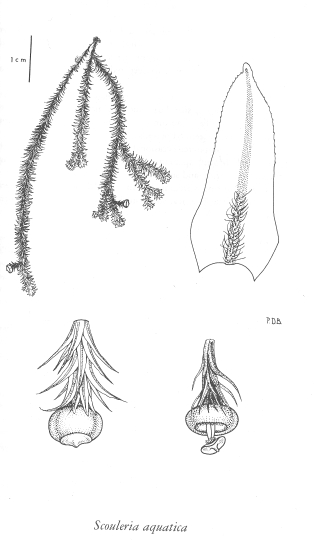Scouleria aquatica Hook.
streamside moss (blackmat splashzone moss)
Scouleriaceae
Species Account Author: Wilf Schofield
Extracted from Some Common Mosses of BC
Introduction to the Bryophytes of BC
streamside moss (blackmat splashzone moss)
Scouleriaceae
Species Account Author: Wilf Schofield
Extracted from Some Common Mosses of BC
Introduction to the Bryophytes of BC
Species Information
Species description:
Genus named in honour of J. Scouler, a Scottish naturalist and surgeon who made collections in western North America in the 19th century. Species name denoting its aquatic habitat.
Reproduction:
Sporophytes occasional, compressed-sub spherical, immersed, glossy dark brown to black when mature in summer.
Distinguishing characteristics:
Plants of this species form remarkable dark green to blackish masses on the rocks that flank rivers; especially luxuriant in the Fraser River Canyon. The toothed leaf margins, frequent presence of rhizoids on the lower midrib, very strongly divergent leaves, when moist, and habitat of splashed or irrigated rock surfaces are useful features; the very short seta and compressed-sub spherical, shiny black sporangia that retain the operculum on the columella long after spores are shed, are also useful features.
Habit:
Dark green to nearly black turfs firmly attached to substratum by black rhizoids; leaves strongly divergent to squarrose when moist, imbricate when dry.
Similar Species:
Schistidium rivulare and Orthotrichum rivulare grow in the same habitat and superficially resemble R. aciculave but their sporangia have an inconspicuous seta. R. aquaticum usually has yellow-green plants and the leaf apex is strongly tapered to a bluntish point and shows no blunt marginal teeth on the leaves. Scouleria aquatica, also· of similar habitats, has sporophytes with very short setae and sporangia are sub spherical rather than cylindric. The leaves of Scouleria are strongly divergent when wet; those of R. aciculare are slightly divergent. R. pacificum is a smaller species of open outcrops near the coast; it has narrow tapering leaves that are rather blunt-tipped but lack widely spaced marginal teeth and the peristome teeth radiate outward when dry; in R. aciculare they are erect.
Illustration

If more than one illustration is available for a species (e.g., separate illustrations were provided for two subspecies) then links to the separate images will be provided below. Note that individual subspecies or varietal illustrations are not always available.
Illustration Source: Some Common Mosses of BC
Habitat and Range
Habitat
Intermittently flooded, splashed or irrigated rock surfaces in or flanking watercourses from near sea level to sub alpine elevations.Range
World DistributionEastern U.S.S.R. and northwestern North America; in North America from Alaska and Yukon to California and eastward to the Rocky Mountains of southern Colorado.